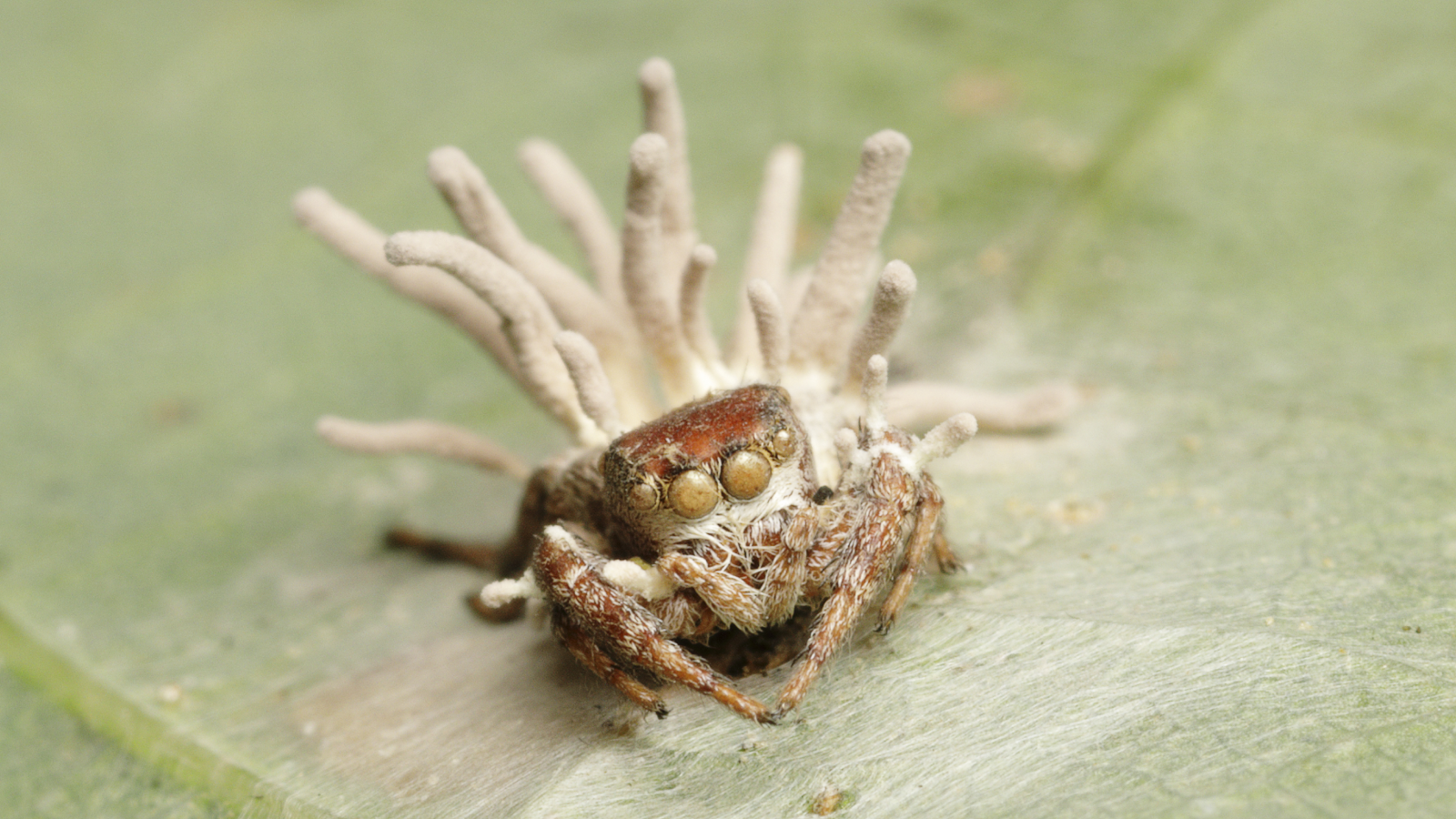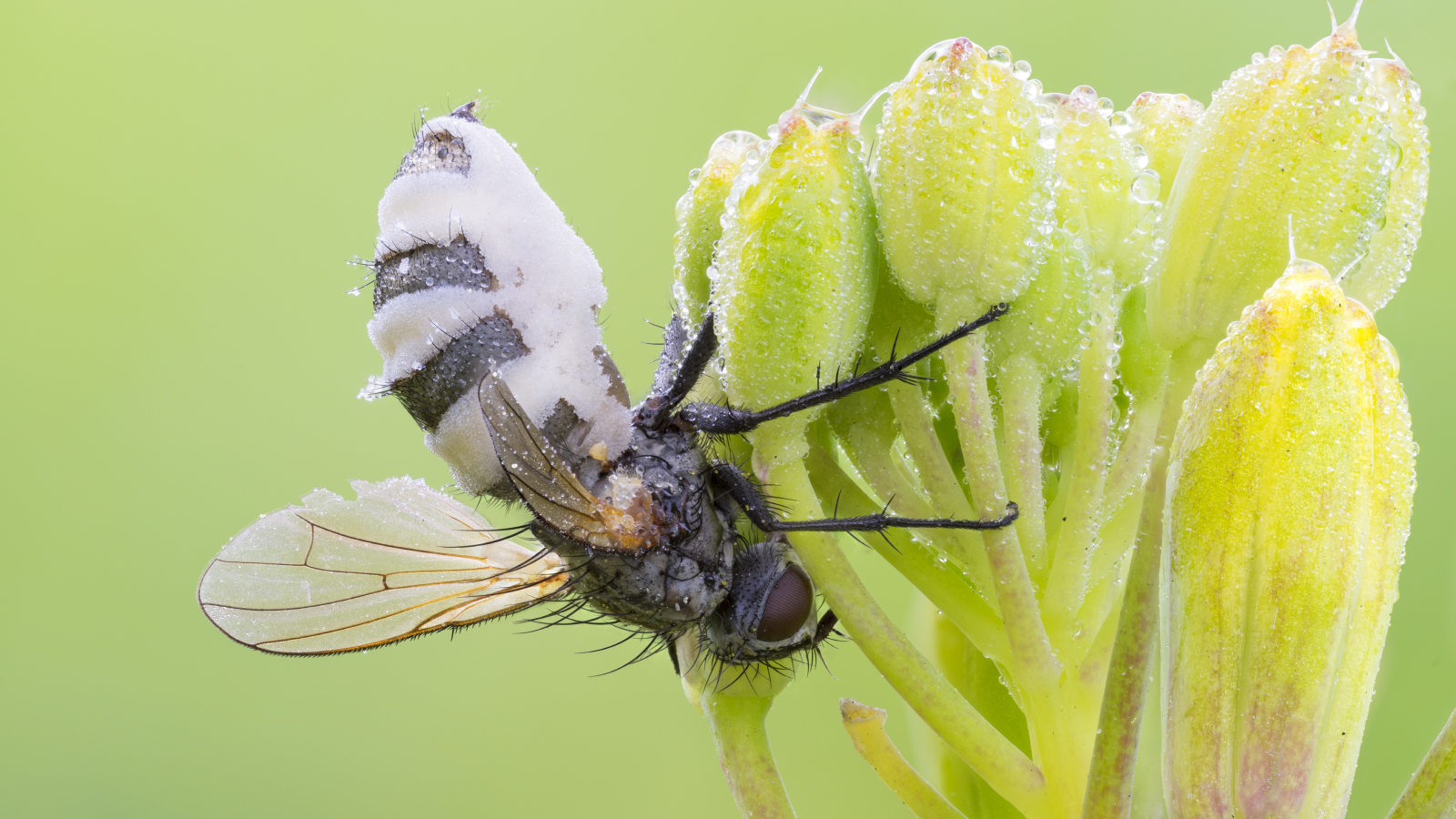These 6 images show the moment when parasites burst from their hosts — and they're scary
Watch as these gruesome parasites emerge from their hosts.

The interaction between parasites and their hosts can be gruesome: They manipulate, invade and terrorize their unsuspecting hosts, often killing them in the process. From mind-controlling organisms to flesh-eating invaders, here's a horrifying set of videos and pictures that capture the moment when parasites burst from their hosts.
Horsehair parasite forces praying mantis to drown itself
In this video, a parasitic nematode escapes the body of a praying mantis abdomen that is under water.
The parasite in question is Coptotermes formosanus, more commonly known as a horsehair worm. These worm-like parasites alter their host's behavior, compelling them to seek out water.
Adult horsehair worms lay their eggs in a slimy string in aquatic environments. Upon hatching, the larvae are eaten by juvenile insects that mantids prey on.
When a mantis eats an infected insect, the parasite larva awakens and uses its sharp appendage to bore through the mantis' gut, moving into its body cavity to absorb the nutrients there. Around three months later, the mature parasite, now up to 35 inches (90 centimeters) long, releases proteins that take over the host's nervous system, directing it towards water.
The parasite forces the mantis to drown itself, and the parasite then wriggles away. Leaving the hollow corpse afloat, the adult worm ventures off to find a spot to lay eggs.
Related: Green-banded broodsac: The brain-hijacking parasite that creates disco zombie snails
Get the world’s most fascinating discoveries delivered straight to your inbox.
Fungus explodes from fly abdomen

In this photo, parasitic fungus spores (Entomophthora muscae) explode from the body of a common tiger fly (Coenosia tigrina).
E. muscae spores bury into the host's exoskeleton to reach the hemolymph — the blood-like fluid in an insect's body. The fungus then grows inside the body, targeting fat cells and body tissues for energy, sparing vital organs to keep the host alive.
After five to seven days, when all nutrients are depleted, the fungus seeks a new home. It attacks the host's brain, taking control of its behavior. The fly is forced to land on a surface and crawl upwards to a high point. Once perched on a high leaf, the infected fly expands its wings and shakes its abdomen to ensure a widespread dispersal. After a few hours the fly dies while the fungus forcefully launches its spores out of the fly's abdomen.
Caterpillar eaten alive by wasps
In this video, larvae of the braconid wasp spin silk cocoons after eating their way out of a heavily parasitized apple sphinx caterpillar (Sphinx poecila).
Mature female braconid wasps lay their eggs in their hosts using an ovipositor — a tube-like, egg-laying organ that extends from their rear — to pierce their chosen host (typically caterpillars, beetles and spiders) and lay eggs inside the host. Once the eggs hatch within the host, the larvae will feed on the organs, eventually killing the host. The wasp larvae that emerge spin silk cocoons attached to the caterpillar corpse, where they will grow into wasps.
Pearlfish inside sea cucumber butt
This video shows the peaking head of graceful pearlfish (Encheliophis gracilis), hiding in the anus of a sea cucumber (Bohadschia argus).
E. gracilis is an eel-shaped fish with a brown, slender body that tapers off into a thin tail. It is a common parasite of sea cucumbers and sea stars . They live in the body cavity of their host, feeding on the host's gonads and other body tissues.
They live in shallow, tropical waters and rely on their sense of smell to find a host. Sea cucumbers breathe through their anus, which rhythmically contracts to pull in water and retrieve the oxygen. The pearlfish has to time its entry perfectly; if the sea cucumber senses its presence, it will close up its anus. To minimize the risk of being caught, the pearlfish enters tail-first, reversing inside.
Sea cucumbers are remarkable regenerators and can grow back their lost body parts. So not only does the body cavity provide shelter and protection for the pearlfish but also a consistent supply of food.
Cordyceps fungus takes over jumping spider

In this image, a macabre crown of fungal fruiting bodies (Gibellula sp.) emerges from this jumping spider corpse.
The genus Gibellula is a parasitoid within the Cordycipitaceae family — a specialized spider-killer. They are commonly known for their extreme growth, completely enveloping the host spider, which makes identification of the host impossible.
When a spider comes into contact with Gibellula spores, the spores begin to germinate on the host and penetrate its exoskeleton. The fungus continues to grow within the spider's body, digesting the spider from the inside out, eventually killing the host.
There is some evidence that it may control the host's behavior. Overgrown fungus-covered spider corpses are often found on the underside of high leaves, which could help the dispersal of spores to reach their next host.
Fly larvae bursts out of a slug caterpillar
The grub of a fly parasitoid (Tachinidae) emerges from the body of a red-crossed button slug caterpillar (Tortricidia pallida).
In spring, Tachinid flies use their ovipositors to lay tiny, sticky eggs on the surface of caterpillars. They use sharp ovipositors to inject the eggs directly into the body. Once these eggs hatch, they burrow into the body of the caterpillar and feed on its gut wall. Most tachinid flies consume the insides entirely before emerging from the body.
In this video, the larva can be seen developing inside, grown to fill the host's body before it bursts out of the host and crawls away.

Elise studied marine biology at the University of Portsmouth in the U.K. She has worked as a freelance journalist focusing on the aquatic realm.




